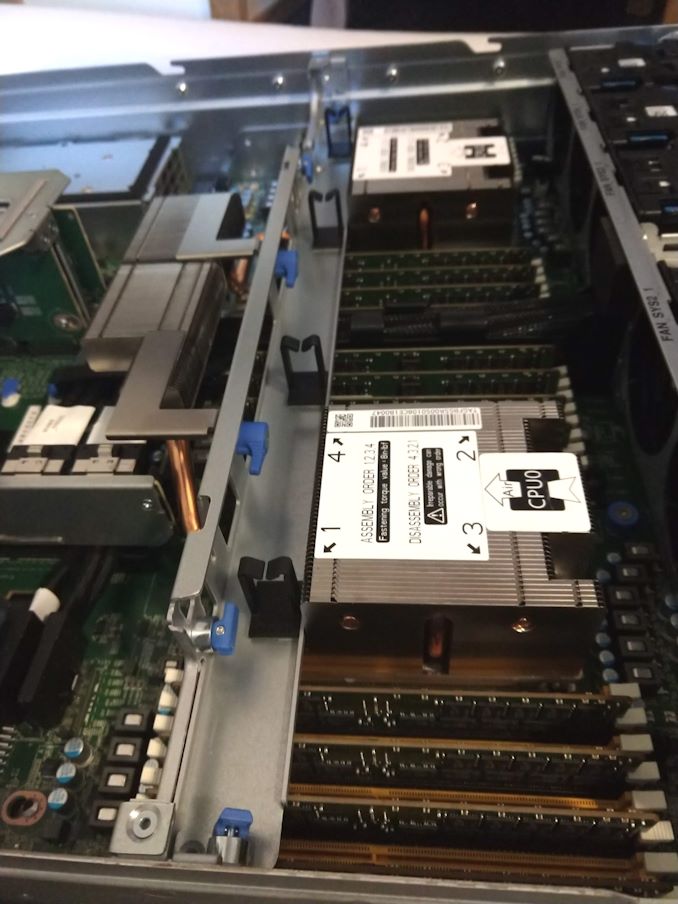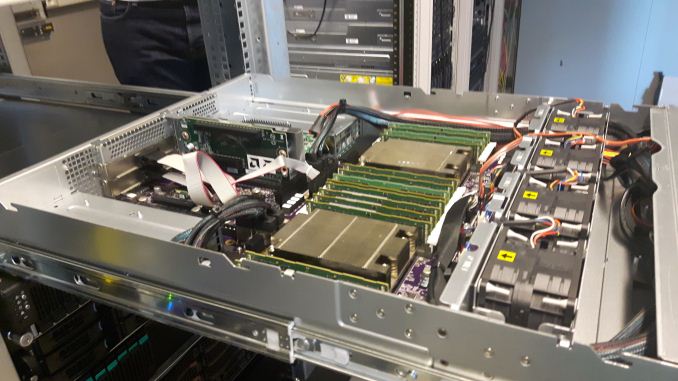AMD Rome Second Generation EPYC Review: 2x 64-core Benchmarked
by Johan De Gelas on August 7, 2019 7:00 PM ESTMurphy's Law
Anything That Can Go Wrong, Will Go Wrong
For those of you that may not know, I am an Academic Director of MCT at Howest University here in Belgium. I perform research in our labs here on big data analytics, virtualization, cloud computing, and server technology in general. We do all the testing here in the lab, and I also do launch article testing for AnandTech.
Undoubtedly, like most academic institutions, we have a summer vacation, where our labs are locked and we are told to get some sunlight. AMD's Rome launch has happened just as our lab closing started, and so I had the Rome server delivered to my home lab instead. The only issue was that our corresponding Intel server was still in the academic lab. Normally this isn't really a problem - even when the lab is open, I issue testing through remote access and process the data that way, in order to reboot the system and run tests and so forth. If a hardware change is needed, I need to be physically there, but usually this isn't a problem.
However, as Murphy's Law would have it, during testing for this review, our Domain Controller also crashed while our labs were closed. We could not reach our older servers any more. This has limited us somewhat in our testing - while I can test this Rome system during normal hours at the home lab (can't really run it overnight, it is a server and therefore loud), I couldn't issue any benchmarks to our Naples / Cascade Lake systems in the lab.
As a result, our only option was to limit ourselves to the benchmarks already done on the EPYC 7601, Skylake, and Cascade Lake machines. Rest assured that we will be back with our usual Big Data/AI and other real world tests once we can get our complete testing infrastructure up and running.
Benchmark Configuration and Methodology
All of our testing was conducted on Ubuntu Server 18.04 LTS, except for the EPYC 7742 server, which was running Ubuntu 19.04. The reason was simple: we were told that 19.04 had validated support for Rome, and with two weeks of testing time, we wanted to complete what was possible. Support (including X2APIC/IOMMU patches to utilize 256 threads) for Rome is available with Linux Kernel 4.19 and later.
You will notice that the DRAM capacity varies among our server configurations. This is of course a result of the fact that Xeons have access to six memory channels while EPYC CPUs have eight channels. As far as we know, all of our tests fit in 128 GB, so DRAM capacity should not have much influence on performance.
AMD Daytona - Dual EPYC 7742
AMD sent us the "Daytona XT" server, a reference platform build by ODM Quanta (D52BQ-2U).
| CPU | AMD EPYC 7742 (2.25 GHz, 64c, 256 MB L3, 225W) |
| RAM | 512 GB (16x32 GB) Micron DDR4-3200 |
| Internal Disks | SAMSUNG MZ7LM240 (bootdisk) Micron 9300 3.84 TB (data) |
| Motherboard | Daytona reference board: S5BQ |
| PSU | PWS-1200 |
Although the 225W TDP CPUs needs extra heatspipes and heatsinks, there are still running on air cooling...
AMD EPYC 7601 – (2U Chassis)
| CPU | Two EPYC 7601 (2.2 GHz, 32c, 8x8MB L3, 180W) |
| RAM | 512 GB (16x32 GB) Samsung DDR4-2666 @2400 |
| Internal Disks | SAMSUNG MZ7LM240 (bootdisk) Intel SSD3710 800 GB (data) |
| Motherboard | AMD Speedway |
| PSU | 1100W PSU (80+ Platinum) |
Intel's Xeon "Purley" Server – S2P2SY3Q (2U Chassis)
| CPU | Two Intel Xeon Platinum 8280 (2.7 GHz, 28c, 38.5MB L3, 205W) Two Intel Xeon Platinum 8176 (2.1 GHz, 28c, 38.5MB L3, 165W) |
| RAM | 384 GB (12x32 GB) Hynix DDR4-2666 |
| Internal Disks | SAMSUNG MZ7LM240 (bootdisk) Micron 9300 3.84 TB (data) |
| Motherboard | Intel S2600WF (Wolf Pass baseboard) |
| Chipset | Intel Wellsburg B0 |
| PSU | 1100W PSU (80+ Platinum) |
We enabled hyper-threading and Intel virtualization acceleration.












180 Comments
View All Comments
schujj07 - Friday, August 9, 2019 - link
The problem is Microsoft went to the Oracle model of licensing for Server 2016/19. That means that you have to license EVERY CPU core it can be run on. Even if you create a VM with only 8 cores, those 8 cores won't always be running on the same cores of the CPU. That is where Rome hurts the pockets of people. You would pay $10k/instance of Server Standard on a single dual 64 core host or $65k/host for Server DataCenter on a dual 64 core host.browned - Saturday, August 10, 2019 - link
We are currently a small MS shop, VMWare with 8 sockets licensed, Windows Datacenter License. 4 Hosts, 2 x 8 core due to Windows Licensing limits. But we are running 120+ majority Windows systems on those hosts.I see our future with 4 x 16 core systems, unless our CPU requirements grow, in which case we could look at 3 x 48 or 2 x 64 core or 4 x 24 core and buy another lot of datacenter licenses. Because we already have 64 cores licensed the uplift to 96 or 128 is not something we would worry about.
We would also get a benefit from only using 2, 3, or 4 of our 8 VMWare socket licenses. We could them implement a better DR system, or use those licenses at another site that currently use Robo licenses.
jgraham11 - Thursday, August 8, 2019 - link
so how does it work with hyper threaded CPUs? And what if the server owner decides to not run Intel Hyperthreading because it is so prone to CPU exploits (most 10 yrs+ old). Does Google still pay for those cores??ianisiam - Thursday, August 8, 2019 - link
You only pay for physical cores, not logical.twotwotwo - Thursday, August 8, 2019 - link
Sort of a fun thing there is that in the past you've had to buy more cores than you need sometimes: lower-end parts that had enough CPU oomph may not support all the RAM or I/O you want, or maybe some feature you wanted was absent or disabled. These seem to let you load up on RAM and I/O at even 8C or 16C (min. 1P or 2P configs).Of course, some CPU-bound apps can't take advantage of that, but in the right situation being able to build as lopsided a machine as you want might even help out the folks who pay by the core.
azfacea - Wednesday, August 7, 2019 - link
FNikosD - Wednesday, August 7, 2019 - link
Ok guys...The Anandtech's team had a "bad luck and timming issues" to offer a true and decent review of the Greatest x86 CPU of all time, so for a proper review of EPYC Rome coming from the most objective and capable site for servers, take a look here:https://www.servethehome.com/amd-epyc-7002-series-...
anactoraaron - Thursday, August 8, 2019 - link
Fphoenix_rizzen - Saturday, August 10, 2019 - link
Review article for new CPU devolves into Windows vs Linux pissing match, completely obscuring any interesting discussion about said hardware. We really haven't reached peak stupid on the internet yet. :(The Benjamins - Wednesday, August 7, 2019 - link
Can we get a C20 benchmark for the lulz?